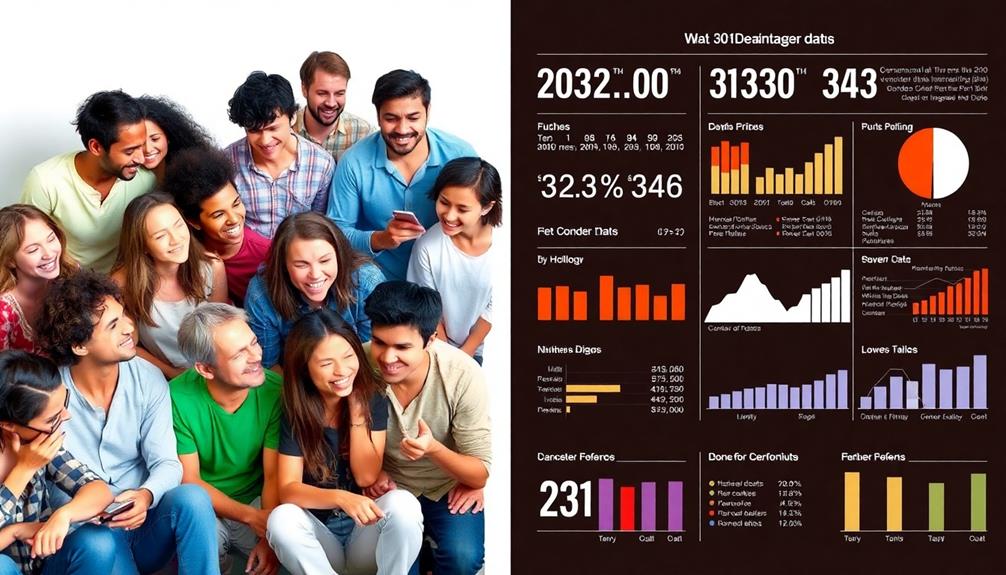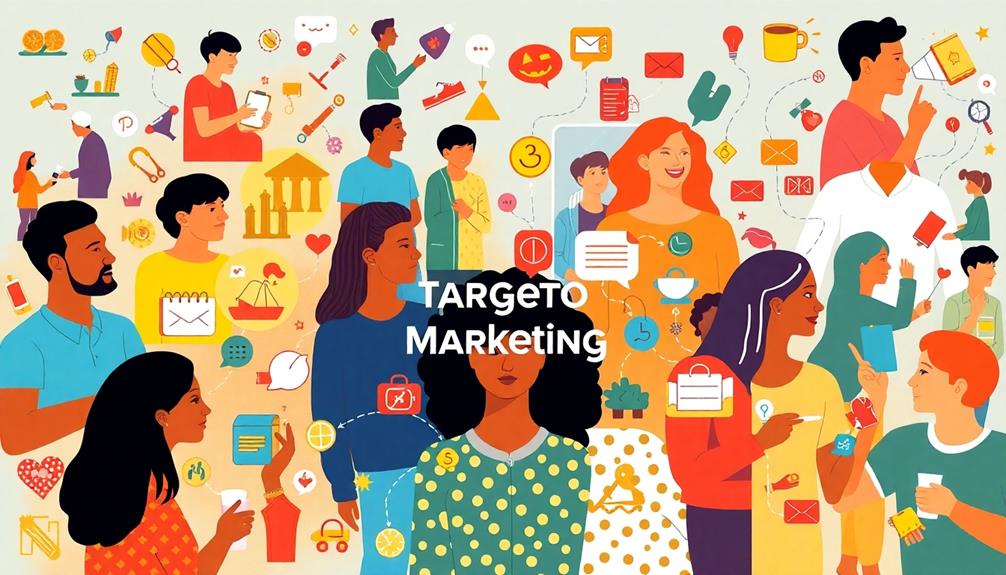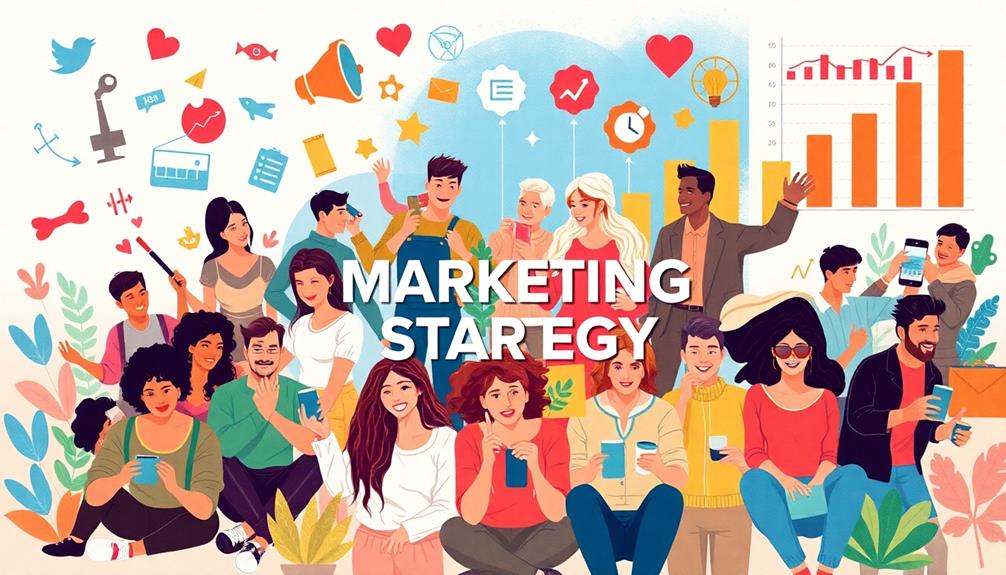Psychographic marketing targets your audience by focusing on their interests, values, and lifestyles. Unlike demographics, which provide basic information like age or income, psychographics dives deeper into what motivates people to make purchasing decisions. This approach enhances brand loyalty by connecting emotionally with consumers who share similar values. For example, brands like Patagonia resonate with eco-conscious buyers, while Nike champions social causes. By understanding these factors, you can create tailored marketing strategies that greatly boost engagement and conversions. Stick around, and you'll discover more ways to harness psychographic insights for your marketing efforts.
Key Takeaways
- Psychographic marketing focuses on consumer attitudes, values, and lifestyles, enhancing emotional connections and brand loyalty.
- It integrates qualitative psychographic insights with demographic data to create detailed buyer personas for effective targeting.
- Key factors include consumer values, lifestyle choices, and interests, influencing purchasing decisions and brand engagement.
- Techniques such as surveys, focus groups, and social media analysis gather valuable psychographic data for tailored marketing strategies.
- Successful campaigns, like Nike's and Patagonia's, demonstrate the power of aligning brand messaging with consumer values and interests for higher engagement.
Understanding Psychographics

Understanding psychographics goes beyond mere demographics; it explores the attitudes, values, and lifestyles that shape consumer behavior. By diving into psychographic data, you can gain insights into your target audience's interests and values, which are essential for effective marketing strategies.
This segmentation method allows you to create psychographic profiles that consider personality traits, lifestyle choices, and social class, giving you a clearer picture of purchasing behavior. Additionally, understanding how external factors like currency fluctuations can impact consumer spending may enhance your marketing approach.
When you leverage psychographic information, you can craft tailored messages that resonate emotionally with your audience, enhancing engagement and improving conversion rates. For instance, if you know your target audience values sustainability, you can highlight eco-friendly aspects of your product.
This approach not only influences purchasing behavior but also fosters brand loyalty, as consumers feel more connected to brands that align with their values.
Collecting psychographic data through surveys, social media analysis, and online behavior tracking enables you to understand your customers thoroughly. Successful brands utilize this information to refine their marketing strategies, creating personalized experiences that set them apart from competitors.
Embracing psychographics will ultimately help you connect with your audience on a deeper level and drive long-term success.
Psychographics vs. Demographics

Marketers often juggle psychographics and demographics to paint a fuller picture of their target audience. While demographics provide objective data like age, gender, and income, psychographics dive deeper into consumer motivations, values, and interests. This qualitative insight is essential for understanding the attitudes and beliefs that drive purchasing behaviors.
By fostering resilience and adaptability, marketers can better respond to changing consumer preferences and enhance their strategies.
Demographic data offers a broad overview, but it often lacks the depth needed for effective marketing strategies. By integrating psychographics, you can create thorough buyer personas that resonate emotionally with your target audiences. This approach not only enhances your messaging but also differentiates your brand in competitive markets.
Attitudes and beliefs can greatly influence purchasing decisions, revealing why consumers choose one product over another. Relying solely on demographics may leave gaps in your understanding of what truly matters to your customers.
In contrast, by focusing on psychographics, you can tailor your campaigns to meet the genuine needs and desires of your audience. Ultimately, combining both demographic and psychographic insights allows for more effective targeting and a stronger emotional connection with consumers.
Psychographic Profiling Techniques

Psychographic profiling techniques are indispensable for creating a nuanced view of your target audience. By gathering psychographic data on consumer attitudes, interests, and values, you can develop detailed customer personas that reflect who your audience truly is.
Methods like surveys, focus groups, and social media analysis help you uncover the key variables such as personality traits, lifestyle choices, and activities. Understanding these aspects is essential, as it aligns closely with the principles of cultural intelligence, which emphasizes adapting to diverse consumer perspectives.
Effective data collection and analysis are imperative for understanding consumer motivations and preferences. As you continuously gather insights, you'll be able to adjust your marketing strategies to align with evolving consumer behaviors and attitudes. This approach not only enhances your audience insights but also allows for the creation of more targeted marketing campaigns that resonate deeply with your audience.
For instance, brands like Patagonia exemplify how to leverage psychographic profiling. They tailor their messaging to eco-conscious consumers, aligning their marketing strategies with customer values and creating a strong emotional connection.
Key Psychographic Factors

When you think about what drives your purchasing decisions, values, lifestyle choices, and interests play a huge role.
These key psychographic factors shape not only how you see the world but also what brands resonate with you.
In a similar vein, understanding student motivations and learning styles can enhance personalized learning experiences in educational settings.
Values and Beliefs
Values and beliefs play an essential role in shaping your purchasing decisions, as they dictate what you prioritize in products and services. When brands align with your values, you're more likely to develop brand loyalty and engage deeply with their offerings.
Additionally, consumers with higher net worth, such as those with $5 million, may have distinct values regarding investment and wealth management strategies. Here are three key reasons why values and beliefs matter:
- Emotional Connections: Brands that resonate with your ideals foster stronger emotional ties, making you feel understood and valued.
- Tailored Campaigns: By utilizing psychographic segmentation, marketers can craft campaigns that speak directly to your beliefs and interests, enhancing engagement.
- Niche Markets: Understanding specific values allows brands to identify and cater to niche markets, addressing unique needs often missed by broader marketing strategies.
Research indicates that 71% of consumers prefer brands reflecting their personal values, underscoring the importance of aligning marketing strategies with these psychographic factors.
When brands successfully connect with their target audience on a values level, they not only improve conversion rates but also build lasting relationships.
Lifestyle Choices
Shaping your purchasing habits, lifestyle choices are key psychographic factors that influence how you engage with brands. Your daily habits, leisure activities, and health consciousness play a significant role in your consumer behavior.
In fact, 66% of consumers like you prefer brands that align with personal values and social beliefs. If you prioritize sustainability, you're more likely to connect with brands showcasing eco-friendly practices, which can boost your purchase intent by 55%.
Additionally, many health-conscious consumers are increasingly incorporating nutritious ingredients like chia seeds into their diets, driven by the awareness of their numerous health benefits, such as being a rich source of omega-3s and promoting heart health high omega-3 content.
The growing trend of health and wellness has also led to a 30% increase in demand for products that cater to fitness-oriented lifestyles. This shift highlights the importance of targeted marketing strategies that resonate with your lifestyle choices.
Understanding these choices allows brands to create personalized experiences, as 72% of customers expect tailored interactions based on their interests and preferences.
Interests and Hobbies
Interests and hobbies play an essential role in shaping your consumer behavior, reflecting your passions and guiding your purchasing decisions. By understanding what you enjoy, brands can connect with you on a deeper level. For instance, individuals who are health-conscious may be drawn to brands promoting wellness products or cold medications overview that align with their values.
Here are three key ways interests and hobbies impact marketing strategies:
- Tailor Messaging: Brands can create tailored messages that resonate with your specific interests, making them more appealing.
- Build Emotional Connections: When brands align with your hobbies—like cooking or fitness—they enhance emotional connections, fostering loyalty.
- Increase Conversion Rates: Research shows that consumers are more likely to engage with brands that reflect their interests, leading to higher conversion rates.
Data collection through surveys and social media interactions reveals trending interests among consumers, enabling marketers to design targeted content.
By segmenting audiences based on interests, companies can refine their strategies to create meaningful experiences. Ultimately, when brands resonate with your passions, they not only enhance brand loyalty but also positively influence your purchasing decisions.
Data Collection Methods

To effectively gather psychographic data, marketers can leverage various methods that provide insights into consumer behavior and preferences. Surveys and questionnaires are a cost-effective way to collect psychographic data directly from target audiences, revealing their attitudes, interests, and values.
Additionally, understanding consumer preferences can be enhanced by evaluating their needs, such as when considering robot vacuum features. Customer interviews, especially non-scripted ones, offer rich qualitative insights, uncovering deeper motivations that influence buying behavior.
Additionally, social media engagement analysis helps you understand user interests and values by monitoring interactions, comments, and shares related to your brand and industry. This real-time feedback can inform your marketing communications strategy.
Online analytics tools, like Google Analytics, track user behavior, allowing you to identify patterns and preferences that enhance psychographic segmentation.
Focus groups are another valuable method, facilitating discussions that uncover collective attitudes and perceptions. These sessions provide insights into consumer motivations and how they relate to your product offerings.
Applying Psychographic Insights

Applying psychographic insights can greatly transform your marketing strategy. By understanding the deeper motivations and values of your target audience, you can craft messages that truly resonate.
Additionally, as companies increasingly prioritize skills and personal values over geographic location, incorporating psychographic factors can enhance your outreach to diverse groups, especially in areas like AI online jobs.
Here are three ways to apply these insights effectively:
- Create Detailed Buyer Personas: Combine psychographic data with demographic data to develop thorough buyer personas. This guarantees your marketing campaigns are tailored to the unique characteristics of different segments.
- Craft Personalized Messages: Use insights on consumer motivations to design personalized messages that align with your audience's values and interests. This approach enhances engagement and fosters emotional connections with your brand.
- Enhance Customer Retention: By continuously leveraging psychographic insights, you can adapt your product offerings and marketing strategies to meet the evolving needs of your customers. This not only boosts customer loyalty but also improves retention rates.
Successful companies like Nike and Apple demonstrate the power of psychographic marketing by creating campaigns that resonate on a personal level.
Benefits of Psychographic Marketing

Psychographic marketing brings several benefits that can transform how you connect with your audience.
By using enhanced targeting strategies, you can craft messages that resonate more deeply, improving brand loyalty and fostering stronger relationships.
Understanding consumer interests, such as their aquatic adventures, allows you to create campaigns that truly reflect what your customers value.
Plus, gaining deeper consumer insights allows you to create campaigns that truly reflect what your customers value.
Enhanced Targeting Strategies
By leveraging psychographic marketing, brands can markedly enhance their targeting strategies, allowing for a deeper connection with consumers. This approach focuses on the values and interests of your target audience, leading to more effective marketing campaigns.
Here are three key benefits:
- Higher Engagement Rates: Brands using psychographic segmentation can achieve 2-3 times the engagement rates because their messages resonate on an emotional level.
- Enhanced Customer Satisfaction: By understanding the attitudes and beliefs of your audience, you can craft campaigns that address specific pain points, ultimately enhancing customer satisfaction.
- Increased Brand Affinity: Unique consumer insights reveal preferences such as sustainability, allowing you to align your product development with what matters to your audience, boosting brand affinity.
Incorporating psychographics into your strategy leads to a personalized shopping experience, where customers feel understood and valued.
Improved Brand Loyalty
Improved brand loyalty is a powerful outcome of effectively utilizing psychographic marketing strategies. By tapping into psychographic insights, you can create emotionally resonant messages that align with your target audiences' values and beliefs. This connection fosters deeper relationships, making customers feel understood and valued.
Brands like Nike have reported increased customer retention rates by crafting campaigns that speak directly to the motivations and lifestyles of their consumers.
Personalized marketing strategies based on psychographics can boost customer loyalty by up to 30%. When you engage with customers on a personal level, addressing their specific interests and preferences, they're more likely to stick around. In fact, 70% of consumers are more loyal to brands that demonstrate a clear understanding of their values and interests.
Psychographic segmentation also allows you to develop products and services that meet consumer preferences closely. This consistency in satisfaction and engagement not only enhances brand loyalty but also strengthens your overall brand image.
Ultimately, by effectively leveraging psychographic marketing, you're not just selling a product; you're building a community of loyal customers who share your brand's vision and values.
Deeper Consumer Insights
Revealing deeper consumer insights can transform your marketing strategy, allowing you to connect with your audience on a more meaningful level. By utilizing psychographic data, you can focus on consumer attitudes, interests, and values, which leads to more emotionally resonant messaging.
Here are three key benefits of adopting psychographic marketing:
- Improved Engagement Rates: Tailored marketing strategies informed by psychographic insights can boost engagement rates by up to 50%, enhancing your chances of conversion.
- Stronger Customer Loyalty: When you create personalized experiences, you foster deeper emotional connections with consumers, leading to better customer loyalty.
- Identifying Niche Markets: Psychographic segmentation allows you to pinpoint niche markets, aligning your products and services with specific consumer motivations and desires.
Successful applications of psychographics have shown that campaigns designed around consumer interests yield returns that can exceed industry averages by 20-30%.
Real-World Examples

Psychographic marketing has proven its effectiveness through various successful campaigns that resonate deeply with specific consumer values and lifestyles. Brands like Nike, Airbnb, and Patagonia have capitalized on psychographic segmentation examples to create targeted campaigns. For instance, Nike's "Dream Crazier" campaign empowered female athletes, aligning with values of gender equality and driving brand loyalty among women. Similarly, Airbnb's "Live There" campaign appealed to travelers' desires for authenticity, enhancing its market segmentation and campaign effectiveness.
Here's a quick overview of notable examples:
| Brand | Campaign Name |
|---|---|
| Nike | Dream Crazier |
| Airbnb | Live There |
| Patagonia | Don't Buy This Jacket |
| Dove | Real Beauty |
| Coca-Cola | Share a Coke |
Dove's "Real Beauty" campaign promoted body positivity, while Coca-Cola's "Share a Coke" created an emotional connection through personalized marketing. Each of these campaigns effectively engaged their target audience by tapping into shared values and interests, showcasing how understanding customer data can lead to increased brand loyalty and successful marketing outcomes.
Enhancing Marketing Strategies

To elevate your marketing strategies, incorporating psychographic insights can make all the difference. By understanding the values, interests, and lifestyles of your target audience, you can create campaigns that truly resonate.
Here are three key benefits of using psychographic data in your marketing efforts:
- Enhanced Engagement Rates: Tailored messaging that aligns with consumer motivations can boost engagement rates by up to 50%, fostering deeper connections.
- Increased Brand Loyalty: Brands like Nike and Apple exemplify how reflecting your audience's beliefs can enhance brand loyalty, leading to improved customer retention.
- Higher Return on Investment: By directing your marketing strategies toward consumers most likely to convert, you'll maximize your return on investment.
Regularly analyzing psychographic data helps you stay relevant in dynamic market environments.
It allows you to adapt to shifting consumer attitudes and behaviors, ensuring your messaging remains impactful. As you refine your strategies, focus on emotional connections and consumer motivations to create compelling campaigns that not only attract attention but also build lasting relationships with your audience.
Embracing psychographics can transform your marketing efforts into powerful tools for growth.
Frequently Asked Questions
What Are the 5 Types of Psychographic Segmentation?
You can explore five types of psychographic segmentation: personality, lifestyle, social class, activities/interests/opinions, and attitudes. Each one helps you understand consumer behavior, allowing you to tailor your marketing strategies effectively.
What Are Psychographics in Target Audience?
Psychographics in target audience focus on understanding your interests, values, and lifestyles. It helps you connect emotionally, ensuring marketing messages resonate with your motivations, ultimately influencing your purchasing decisions and enhancing your overall experience.
What Is Psychographic Segmentation of Values?
Think of psychographic segmentation of values as a compass guiding your purchase decisions. It categorizes you based on beliefs and principles, helping brands connect emotionally and resonate with your core motivations and preferences.
What Are the 4 Variables of Psychographic Segmentation?
The four variables of psychographic segmentation are personality traits, lifestyle choices, social status, and activities, interests, and opinions. Each variable helps you understand consumer behavior, guiding you to create more effective marketing strategies.
Conclusion
Incorporating psychographic marketing into your strategies is like finding the perfect key to access a treasure chest of customer insights. Just as a skilled locksmith understands the unique patterns of each lock, you too can identify the specific interests and values that resonate with your audience. By doing this, you'll not only enhance engagement but also foster loyalty, ensuring your brand shines brighter in a crowded marketplace. So, grab that key and start exploring the riches within!










